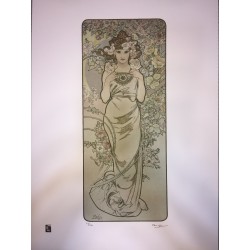Art Nouveau
Art Nouveau, and its declinations mistakenly assimilated in Italy to the floral style or Liberty style or (especially at the time) new art, was an artistic and philosophical movement that developed between the end of the 19th century and the first decade of the 1900s and which influenced the figurative arts, architecture and applied arts. The artistic movement had its greatest diffusion during the last period of the so-called Belle Époque.
The name Art Nouveau ("new art") was coined in France, a country in which the movement was also known as Style Guimard, Style 1900 or École de Nancy (for art objects); also in Great Britain it was known as Art Nouveau together with the language definitions of Modern Style or Studio Style, while in Germany it took the name of Jugendstil (young style), in Austria Sezessionstil (Secession), in the Netherlands Nieuwe Kunst (translation of Art Nouveau in Dutch), in Poland Secesja, in Switzerland Style sapin or Jugendstil, in Serbia and Croatia Secesija, in Russia Modern and, in Spain, Arte Joven (art young), or more frequently, Modernism. In Italy the artistic movement first took the name of new art and later of floral style or Liberty style.












